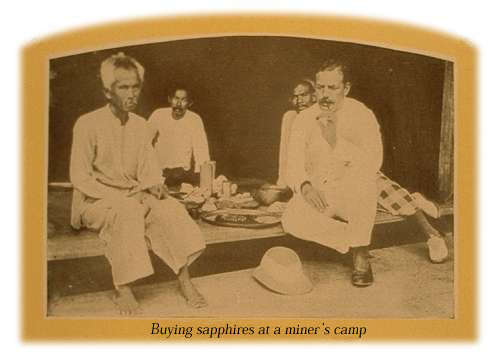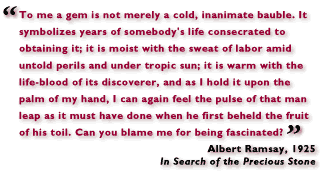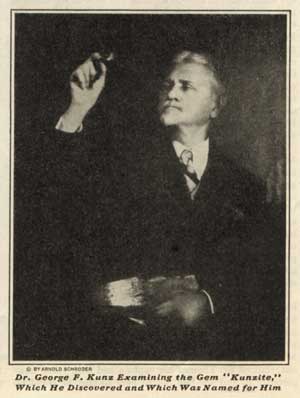|

The Gem Spectrum is Pala International’s
free newsletter. Edited by Pala’s own Gabrièl Mattice,
it is filled with interesting articles on various aspects of gems
and minerals.
We
distribute The Gem Spectrum free
within the United States to members
of the gem and jewelry trades. If
you would like to be added to our mailing
list, please
contact us.


The museum is more than a collection
of things.
It gives a broad view of the human race – our ways
of life, our artistry and ingenuity.
In displaying the beauty of art and nature, it ignites the imagination
and restores the soul.
It can stimulate thought and inspire new ideas.
As children, our value systems are developed
at an early age. I’m not talking about the value system that deems
what is right and wrong, nor what is appropriate. The value system I
refer to is the one which helps us choose the tangible items in our lives
that hold our interest and are therefore deemed special.
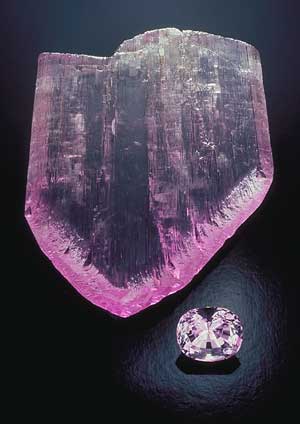 |
Rough and cut kunzite. This gem was named
after famed collector, George F. Kunz.
(Photo: © 1991 Tino Hammid) |
|
Because
mineral specimens are one of Pala’s specialties, we (along with
the support of ‘Mother Nature’) have had a hand in building
mineral collections in some of the world’s most prestigious museums.
In
this issue, we have chosen to re-introduce
you to two of our industry’s earliest
curators.
George
F. Kunz and Albert Ramsay were two real-life
Indiana Jones types. At a time when not much
was known in the field of gemology or advanced
mineralogy, they, as well as many others,
showed the way in the fields of museum acquisitions,
as well as private collecting. They were
men who turned their love of collecting gems
and minerals into professions that stepped
outside traditional retail and manufacturing.
Collectors
are indeed a rare breed in their own right.
From the very earliest of collectors up to
the present day enthusiasts, I have found
that a deep seeded passion for gems and minerals
is the one trait that remains common in their
lineage.
Gem
and mineral collecting is a constant re-education
of one’s self. Without being consciously
aware of it, you are continually familiarizing
yourself with origin and rarity, as well
as structure and aesthetics. Unfortunately
because of the lack of any rational classification
of minerals, printed reference materials
from the earliest of times are not precise,
and have made the origins of many specimens
in the older collections difficult to determine
with any degree of accuracy.
We
at Pala International take pleasure in furthering
the education of collectors, as well as helping
to ensure that mineral specimens are preserved
against the ravages of time. Under the guidance
of owner and avid mineral enthusiast, William
Larson, we have enjoyed advising collectors
of all ages. Hence this issue of the Gem
Spectrum is designed to help stimulate
an interest in gem and mineral collecting.
If
after reading this newsletter you find yourself
inclined to delve a bit further into the
world of gem and mineral collecting, we invite
you to contact us. This can be done via e-mail,
through our website at www.palagems.com,
or simply by calling us at 800-854-1598.
We will be happy to answer your questions,
or send you reprints of the past issues of
the Gem Spectrum for your library. Happy
reading,
|
Gabrièl Mattice, G.G.
Editor |

By George F. Kunz
As told to Marie Beynon Ray
(Reprinted from the Saturday Evening Post, November 26, 1927)
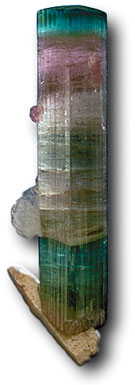 |
San Diego County tourmaline
(Photo: Jeff Scovil)
|
|
Breakfast at Tiffany’s
In those early days… no so-called fancy stones were on sale
in any jewelry store in the country; one could scarcely find them in
a lapidary’s shop, yet, reviewing those that I had gathered, it
seemed to me that many ladies, even those who could afford the gesture
of diamond tiara and pearl choker, would be happy to array themselves
in the endless gorgeous colors of these unexploited gems. As I looked
over a collection of them, with the sunlight imprisoned in the sea-green
depths of the tourmaline, lapping at the facets of the watery-blue
aquamarine, flooding the blood-red cup of the garnet, glancing from
the ice-blue edges of the beryl, melting in the misty nebula of the
moonstone, entangled in the fringes of the moss agate, brilliantly
concentrated in the metallic zircon, forming a milky star in the heart
of of the illusive star sapphire – how, I thought, could a woman
ever resist their subtle appeal?
So one day, buckled in youth, I wrapped a tourmaline in a bit of gem
paper, swung on a horse car, and all the way to my destination rehearsed
my arguments. Arrived there, I was finally received by [Charles Tiffany]
the managing head of what was even then the largest jewelry establishment
in the world, and showed him my drop of green light. I explained – a
very little; the gem itself was its own best argument. Tiffany bought
it – the great dealers in precious stones bought their first tourmaline
from me. The check which crinkled in my pocket as I walked home in the
late afternoon, forgetting there were cars, stargazing, tripping over
curbs, meant very little in comparison with the fact that I had interested
a foremost jeweler of that time in my revolutionary theory and made the
acquaintance of a man who was later to become my close friend.
An Encounter with
Oscar Wilde
“But my dear Kunz,” he
said, “these [semi-precious stones]
are exquisite, charming! I believe I
admire them even more than the precious
stones, for among them, except for rarities,
we have only the four obvious colors,
but here – why, there’s not
a color on land or sea but is imprisoned
in one of these heavenly stones! What
wonderful jewelry could be made with
these subtle phrases of color; such things
as only the ancients and the barbarians
made – work of Egyptians, Greeks
and Romans – such beauties as we
moderns have never concieved. My dear
fellow, I see a renaissance of art, a
new vogue in jewelry...
“And
for those of conservative taste, these
stones can be as handsomely mounted in
present-day settings as the precious
stones,” I added.
He
snapped his fingers, shook that mane
of hair.
“Bah!
Who cares for the conservatives! Give
them their costly jewels and conventional
settings. Let me have these broken lights – these
harmonies and dissonances of color. Can
you price beauty by the carat?”
Oscar Wilde to George
F. Kunz

|

|
|
Update on
the Karkodino and Bobrovka
demantoid mines in the Ural Mountains of Russia
In May, Pala International met with two Russian
suppliers who had just come from the demantoid garnet mines
and thus were able to question them on mining activity
and the production outlook for the year 2000.
Currently,
the cold Russian
winters are giving
way to spring;
however, the
ground is still
frozen and mining
activity is yet
to commence.
Reports from
the Bobrovka mine are
not encouraging.
This historic
deposit has been
worked again
and again, and
both our suppliers
believe that
production from
here is minimal,
at best. Mostly
independent miners
are re-working
tailings or small
alluvial areas
which have been
worked several
times historically
over the last
130 years.
The
finest stone
that we have
seen to date
was a newly mined
5-ct. gem, but
the color was
a little towards
olive. Its asking
price in Russia
was US$4,000/ct.
The Karkodino mine
is an extremely
large deposit
with many small
veins containing
nodules of demantoid
garnet. Many
problems have
been encountered
in mining, the
first of which
is that the mine
cannot have private
ownership under
Russian laws.
Therefore, various
groups have been
trying to mine
simultaneously,
leading to disorganized
and chaotic methods.
In 1999 a large
bulldozing operation
was re-started
in an attempt
to expose more
demantoid veins.
However, what
was accomplished
was typical of
when bulldozers
are used in small
gem mining operations… they
tend to cover
up as much as
they expose.
Now many of the
producing demantoid
veins are buried
under several
feet of newly-dozed
material, thus
making direct
mining of these
veins more difficult,
instead of easier.
The
lack of organized
mining has been
disastrous to
the production,
so that we have
seen supplies
dwindle, as demand
has increased.
There is still
a good supply
of under 1 ct.
melee. However,
top color is extremely rare
(less than 10%
of the overall
production).
Large stones
(anything over
2 cts.) have
been exceedingly
rare also. Last
year both suppliers
estimated they
saw two stones
over 5 cts. that
were of superb
quality and perhaps
only fifty stones
over 2.5 cts.
of all qualities.
We recently sold
a beautiful 9-ct.
oval. However,
it was an off
color. This season’s
production will
be gathered and
cut and we will
see the results
in late July
or August, in
time for the
Hong Kong Show.
There
have been no
new localities
reported, so
it seems that
demantoid production
will remain very
rare, even though
demand has increased
tremendously
as awareness
of new production
hit jewelers
and gemologists
throughout the
world.William
F. Larson, President
News,
News, News from Nigeria
The new find of Nigerian rubellite, coupled
with the simultaneous discovery of spessartine garnet in
the same country, has created quite a bit of excitement
in the trade.
While
both deposits
are producing
excellent qualities,
quantities of
late are disconcerting.
As with any new
deposit, the
old adage of “the
best comes first” again
seems to be fulfilled.
The only difference
here is that
production of
new material
seems to have
ended. We are
no longer seeing
the parcels of
rough that once
were so prevalent.
This fact, coupled
with the verbal
reports from
Nigeria, lead
us to conclude
that these deposits
are about finished.
Now
for the good
news. Being miners
ourselves, Pala
International
anticipated such
a situation and
bought Nigerian
rubellite and
spessartine garnet
in large quantities
from the beginning.
These purchases
will allow Pala
International
to continue to
supply fine-quality
material for
the next several
years.Josh Hall,
Vice-President |
|
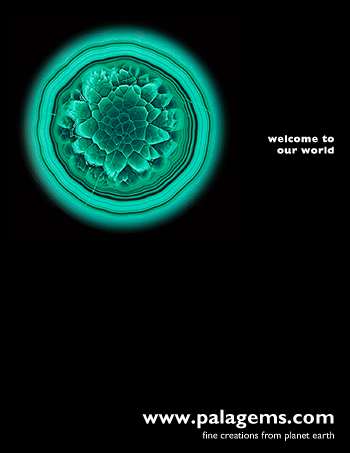 |
Wired:
Welcome to Palagems.com
The World Wide Web has revolutionized the way we interact
with information and Pala International’s website, www.palagems.com,
is set to help you take advantage of it.
Since
opening in Feb. 2000,
Palagems.com has
garnered rave reviews
from both users and
the jewelry trade-press
alike. Jewelers particularly
appreciate the online
database, where a
large percentage
of Pala’s inventory
can be accessed.
It allows quick searches
and is available
24/7. By applying
for a trade password,
jewelers can view
our wholesale prices
online (the general
public is shown no
prices). Another
popular feature is
the Learning Vault,
where articles on
a variety of educational
topics are found.
So
if you have yet to
visit Palagems.com,
find time to do so.
Our world of fine
gems is waiting. |
|
|




